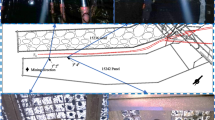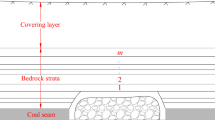Abstract
To study the fissure-stress evolution law of overburden rock in the process of working face advancing in the dual fault area. This paper took the geological occurrence condition and actual mining situation of working face 21,129 of Tucheng mine as the engineering background. The method of similarity simulation combined with field measurement was adopted. The evolution law of the stope fissure field, the stress variation trend of roof fault, and migration characteristics of overlying strata in the process of stope mining through dual faults were studied. The results showed that: Dual faults had a large effective area on the surrounding rock of the stope, the surrounding rock movement in the affected area was intense. When the working face advanced to the fault F2 area, the energy generated during the surrounding rock movement of the fault F2 was transferred to the fault F1, which intensified the activity of the rock in the fault F1 area. The activation of the fault F2 caused the fissures in the surrounding rocks of the fault F1 to expand further. The surrounding rock of the stope changed from a single-fault action mode to a double-fault joint action mode. According to the degree of development of cracks in the roof of the overlying strata, the stope’s different positions were sorted from large to small as follows: fault activated fracture zone > central dual fault zone > open-off cut zone > middle of the non-fault affected zone. The field measured data showed that the area affected by the dual fault was composed of “high-pressure area” and “low-pressure area.” The working resistance value of hydraulic support was higher than that of the non-fault affected area. The law of fracture development and distribution in overlying strata of stope in similarity simulation experiments were consistent with the law of roof pressure measured in the field.










Similar content being viewed by others
Data Availability
Data sharing is not applicable to this article because no data set was generated or suppressed in the currentstudy. The [Tables 1 and 2)] data used to support the findings of this study are included within the article, which is based on thegeological data of the site and some data generated during the experiment. This article contains all the data generated or published during the study; no any other data were used to support this study.
References
Atsushi S, Mitri HS (2014) Dynamic behaviour of mining-induced fault slip. Int J Rock Mech Min Sci 66:19–29
Atsushi S, Mitri HS (2015) Effect of slip-weakening distance on selected seismic source parameters of mining-induced fault-slip. Int J Rock Mech Min Sci 73:115–122
Chang C, Kang TS (2011) Influence of regional fault on the current stress state in southeast Korea. Int Sci 1: 98–103
Hoek E (2007) Practical rock engineering is a vital reference tool for engineers working in rock. A free set of notes is available based on select case histories, each carefully chosen to illustrate the concepts and practical approaches used. North Vancouver
He GQ, Yang L, Ling GD et al (1991) Mining subsidence science. University of Mining and Technology Press, Xuzhou
Jiang JQ, WU QL, Qu H et al (2014a) Evolutionary characteristics of mining stress near the hard-thick overburden normal faults. J Min Saf Eng 31(6):881–887
Ji HG, Ma HS, Wang JA et al (2012) Mining disturbance effect and mining arrangements analysis of near-fault mining in high tectonic stress region. Saf Sci 50(4):649–654
Jiang FX, Wei QD, Wang CW et al (2014b) Analysis of rock burst mechanism in extra-thick coal seam controlled by huge thick conglomerate and thrust fault. J China Coal Soc 39(7):1191–1196
Jiao ZH, Zhao YX, Jiang YD et al (2017) Fault damage induced by mining and its sensitivity analysis of influencing factors. J China Coal Soc 42(S1):36–42
Kang HP, Wu ZG (2012) Effect of geological structures on in-situ stress distribution in underground coal mines. Chin J Rock Mech Eng 31(Add):2674–2680
Li ZL, Dou LM, Cai W et al (2015a) Fault-pillar induced rock burst mechanism of thick coal seam in deep mining. Chin J Rock Mech Eng 32(2):333–342
Li ZH, Dou LM, Lu ZY et al (2015b) Study of the fault slide destabilization induced by coal mining. J Min Saf Eng 27(4):499–504
Lu JG, Wang T, Ding WB et al (2018) Induction mechanisms of coal bumps caused by thrust faults during deep mining. J China Coal Soc 43(2):405–416
Pan YS, Li ZH, Zhang MT (2003) Distribution, type, mechanism and prevention of rockbrust in china. Chin J Rock Mech Eng 22(11):1844–1851
Pan LY, Zhang LJ, Liu XG (2006) Prediction and prevention of ground pressure impact. China University of Mining and Technology Press, Xuzhou, pp 132–143
Potvin Y, Jarufe J, Wesseloo J (2015) Interpretationof seismic data and numerical modelling offault reactivation at El Teniente, Reservas Norte sector. Trans Inst Min Metall 119(3):175–181
Qian MG, Shi PW (2003) Mine pressure and rock formation control. China University of Mining and Technology Press, Xuzhou
Ruina A (1983) Slip instability and state variable friction laws. J Geophys Res Atmos 881(B12):10359–10370
Wang JM, Dong SN, LU L et al (1997) Mining disturbanceon faults in panel and the hydrogeological effect. J China Coal Soc 22(4):27–31
Xia YX, Wang JH, Mao DM (2016) Analysis of fault activation induced rock burst risk based on in-situ stress measurements. J China Coal Soc. 12:3008–3015
Yu WJ, Wu GS (2018) Deformation characteristics and stability control of soft coal–rock mining roadway in thin coal seam. J China Coal Soc 43(10):2668–2678
Yu WJ, Wu GS, An BF, Zhang J (2019) Large deformation characteristics and stability control of roadway with fractured rock mass. J Min Saf Eng 36(01):103–111
Zhang ZT, Gao WH (2020) Effect of different test methods on the disintegration behaviour of soft rock and the evolution model of disintegration breakage under cyclic wetting and drying. Eng Geol 279:105888. https://doi.org/10.1016/j.enggeo.2020.105888
Zhang ZT, Gao WH, Wang X, Zhang JQ, Tang XY (2020) Degradation-induced evolution of particle roundness and its effect on the shear behaviour of railway ballast. Transp Geotech 24:100388. https://doi.org/10.1016/j.trgeo.2020.100388
Zhang ZT, GaoWH, Zeng CF, Tang XY, Wu J (2020b) Evolution of the disintegration breakage of red-bed soft rock using a logistic regression model. Transp Geotech 24:100382
Zhu GA, Dou LM, Wang HS et al (2020) Back analysis of rock burst risk and fault slip due to mining in the island panel along fault: a case study of island panel 3108 in Chaoyang coal mine. J China Coal Soc 45(2):533–541
Acknowledgements
This study was supported by National Natural Science Foundation of China (Grant No. 51974117; 51904081,and 51964008), Hunan Provincial Natural Science Foundation of China (Grant No.2020JJ4027), and Science and Technology Planning Project of Guizhou Province (Guizhou Branch And Support [2020] No. 4Y042). The financial supports are greatly appreciated.
Author information
Authors and Affiliations
Corresponding author
Additional information
Publisher’s note
Springer Nature remains neutral with regard to jurisdictional claims in published maps and institutional affiliations.
Rights and permissions
About this article
Cite this article
Guo, H., Yu, W., Liu, Y. et al. Mechanism of Overlying Crack-Stress Evolution When Mining on the Dual Fault Zone. Geotech Geol Eng 39, 3729–3740 (2021). https://doi.org/10.1007/s10706-021-01720-3
Received:
Accepted:
Published:
Issue Date:
DOI: https://doi.org/10.1007/s10706-021-01720-3




